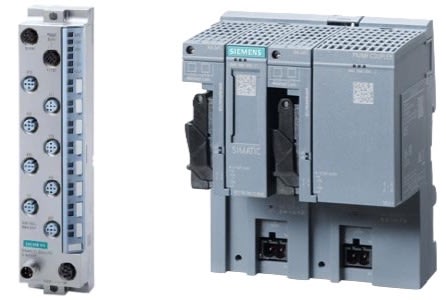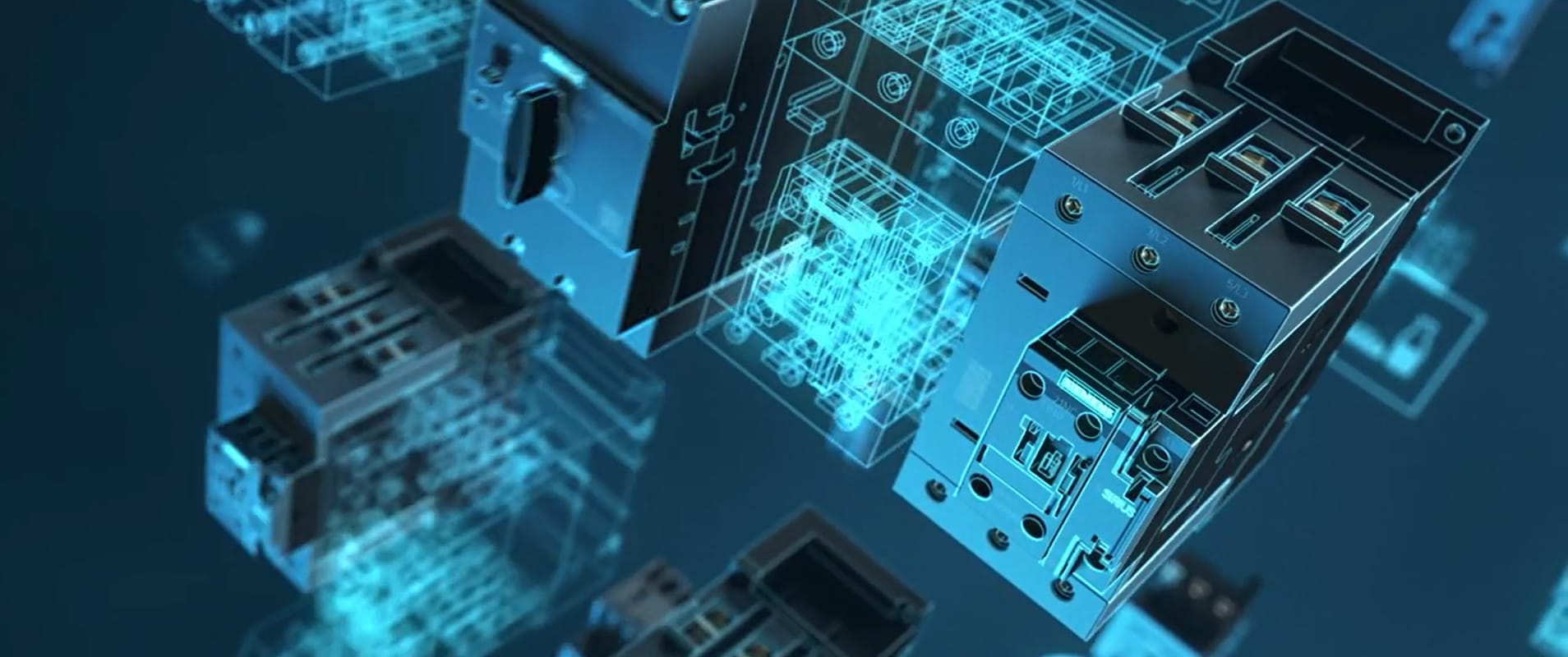Industrial automation and control networks can be complex and costly to maintain. Garett Williams, Siemens Portfolio Development Specialist – Factory Automation, and Raj Rajendra, Siemens Product Marketing Manager – Factory Automation, explain how the right distributed I/O solutions can save you time and money.
For this installment of the RS Expert Advice Series, we spoke to Garett Williams, the Portfolio Development Specialist for Factory Automation at Siemens, and Raj Rajendra, the Product Marketing Manager for Factory Automation at Siemens, about distributed I/O, its role in factory automation applications, and innovative Siemens solutions that can help you simplify and standardize your industrial automation and control networks and save you money.

Q1. Hi Garett. Please introduce yourself and tell us about your role at Siemens and how you ended up working in factory automation.
Garett: I’ve been in the factory automation world for about 24 years now and have been with Siemens almost that whole time, except for a few years where I worked as a director of business development for a systems integrator. I’ve worked in sales, marketing, business development, and management, but it’s always been in the factory automation space. Currently, I’m a product development specialist. I work with our channel partners, distributors, and sales folks, and sometimes even directly with customers, to promote the I/O products within our factory automation portfolio.

Q2. Hi Raj. Same question to you. Please introduce yourself and tell us about your role at Siemens and how you ended up working in factory automation.
Raj: I’ve worked in factory automation for many years — maybe too many. [He kids.] Before I came to the U.S. in 2001, I was working for Siemens in Australia. I had started with Texas Instruments in the industrial automation group, but then Siemens bought that business. Presently, I’m the product manager for distributed I/O and a little logic controller called Logo, and I communicate directly with headquarters to arm our sales force with all of the information about this portfolio. It might look like a small portfolio, but if you look at all the bits and pieces in I/O systems, I have a larger portfolio than anyone else!
Q3. Please introduce us to Siemens.
Garett: Siemens is the largest manufacturer of factory automation products in the world. In terms of market share, we’re the global market leader for primary factory automation components. That usually means a PLC of some sort, or an I/O that fits into a PLC, as well as HMI panels and industrial computers. But what’s unique about Siemens is that we’re the only manufacturer that provides products for a true end-to-end experience with the customer. That means they can start in a digital space with simulation and design in a virtual world, and then we can take that information all the way to the end by providing products to execute that digital design in the physical world.
Q4. What role does I/O play in factory automation and control applications?
Raj: At the field level, you’re going to have a variety of sensors and whatnot — sweepers and meters you want to read and do some control work on, for example. On the other end, you’re going to have a PLC that can be read and programmed. In between them comes the I/O. I/O is the bridge between the sensors and the controller. It collects all the data from the field and passes it on.
Garett: The correct I/O is particularly important for automation control system standardization, and standardization is especially important given the persistence of labor scarcity and the increasing complexity of these systems. With I/O, standardization is often defined by the type of signals that come into the I/O, such as analog or digital, and the types of network communication that the I/O can handle. A controller is going to communicate on a network, which means you need an I/O that will communicate on that same network. Similarly, if you have different fieldbuses that different customers standardize on, you’re going to need an I/O that fits those standards and can communicate on the most common networks and fieldbuses you see in the field.
Q5. What are some essential characteristics of effective distributed I/O systems for factory automation and control applications?
Raj: In the old days, the I/O was typically sitting next to the PLC in a kind of central configuration. This meant that all of the wiring in the field had to start from somewhere remote. So, we were running cable into the field a lot and then traveling to it — often several kilometers away — when there was an issue. This was both complex and costly, as it took time and money to wire everything up. Distributed I/O systems were designed to resolve this. Now, the controller sits in one place, but the I/O sits closer to the sensors, actuators, and other devices. And since they’re in a variety of different locations now, each I/O comes with an IP rating that tells you how much dust or humidity it can tolerate.
Garett: There are two types of distributed I/O. One is the kind that is cabinet-based, which can be very compact or high-density based on need. The other kind is machine-based, sometimes called a machine-mount I/O, which sits outside of the cabinet on the machine itself. This kind could be on a conveyer subjected to severe shock and vibration or in a food manufacturing plant where there’s a lot of grease and oil involved. Either way, the location and application will determine which IP rating you need for your I/O.
Also, machine-mounted I/O can either be a block, which is just a piece of I/O with a few I/O points on it, or a modular system that can be customized for a specific application. At Siemens, we cover all kinds of I/O needs with openness and flexibility.
Q6. Can you tell us about some Siemens solutions that exhibit these characteristics?
Garett: In all cases, what customers are looking for in an I/O is a universal solution. They want something powerful and flexible that can work no matter what their application is. That’s why we offer a wide range of I/O solutions for all different kinds of signal types. Our SIMATIC ET200 Series I/O systems, for instance, have technology modules that can execute tasks including weighing functions, drive functions, and motor starter functions and integrate all of that I/O to provide the power that the customer is looking for in a flexible way.
Openness is really important. Let’s say you’re an OEM. You might ship to one customer that has a certain type of PLC they standardize on, but then they have another customer that standardizes on a different platform. Each standard changes the communication protocol for the I/O, and customers need the ability to quickly and easily adapt their machines to whatever that requirement is. That adaptability, or openness, is a critical way to future-proof your services and provide for customers of all kinds for years to come.
Raj: While there is some overlap, each solution in the SIMATIC ET200 Series has its own unique characteristics that will be relevant to different applications. Which solution you choose will be determined by whether it’s cabinet-based or machine-mounted, if it needs to be modular, and the overall scale of your application. For example, if you just want to read an I/O point and bring it to the PLC, we offer very affordable basic modules that do that. On the other hand, we offer high-feature modules with extensive diagnostics and channel densities on the order of 64. Our standard-performance (ST) solutions are ideal for the former, and our high-feature and high speed (HF and HS) solutions are ideal for complex application needs. They are both modular, powerful, scalable, space-saving, and easy to install and commission, but the ET 200SP is an especially compact I/O system with module sizes up to 16 channels, while the ET 200MP is characterized by a high channel density — up to 64 channels per module — and designed to support both centralized and distributed configurations.
If your application requires the I/O to sit outside of the cabinet, then our ET 200pro solutions would be an excellent choice. This robust, IP67, machine-mounted I/O system is characterized by a comprehensive range of modules that support maximum flexibility and enable near-universal utility and is ideal for companies that want to decentralize but don’t have room for a control cabinet.

Q7. What are MultiFieldbus solutions?
Garrett: Our MultiFieldbus solutions allow you to use the same hardware to communicate with the three most common networks used in the industry today: PROFINET, Ethernet/IP, and Modbus/TCP. Many companies in the U.S. standardize on Ethernet/IP, many companies in Europe standardize on PROFINET, and Modbus is the preferred standard in the energy management industry. So, if you are U.S.-based and want to go into a new project, you’re going to want to show that your I/O can support whatever networks they use. This is exactly what our MultiFieldbus solutions are for. They allow users to standardize on a single I/O platform in their automation projects and make the machine data accessible to IT without making any complex or time-consuming adjustments to the I/Os or replacing the controller, and that’s really important because different protocols are ideally suited for different types of automation applications.

Raj: At Siemens, we offer multiple MultiFieldbus solutions. SIMATIC ET 200 MultiFieldbus interface modules exchange data with connected controllers from various manufacturers via different protocols and can even allow our SIMATIC ET 200SP I/O systems to be used in applications that previously only utilized Modbus TCP or EtherNet/IP. They feature standardized cabinet designs, wiring and test methods, and documentation sets and support a wide range of cabinet and on-machine solutions with models various IP ratings. The SIMATIC ET 200eco PN [pictured left] is a particularly rugged version of this module with a special zinc pressurized housing sealed to IP65/67 or IP69K and rated for operating temperatures extending from -40° to +60°C. The PN/MF Coupler Bus Coupling [pictured right], can communicate via different protocols simultaneously and can be used to connect an EtherNet/IP network to a PROFINET subnet or to interconnect two PROFINET subnets. And both can be configured using our MultiFieldbus Configuration Tool, which is available as a free download, or our Totally Integrated Automation (TIA) Portal. The latest addition to our MultiFieldbus offering is our ET200AL modular block IO system, which also offers IP65/6 ratings.
Q8. Are there any success stories you can share about Siemens’ SIMATIC ET 200 modular, distributed I/O systems?
Garett: There are! We recently published a case study that showed how our SIMATIC ET 200SP MultiFieldbus I/O module has been championed by Viking Electric, a major supplier of electrical components and services in the Midwest. After learning of our module’s ability to communicate with third-party PLCs on any major network, they have since gone to great lengths to educate their customers about how solutions like ours can improve standardization and third-party interoperability. One Viking Electric customer, a glass manufacturer, even said that their current existing controller costs nearly twice as much to use compared to the SIMATIC ET 200SP MultiFieldbus I/O module, so it offers savings as well.
Raj: There are tons of wins we’ve both had personally over the years. Some of them are very large installations. The latest and greatest we had was a steel plant that used 50,000 I/O points, more than 200 stations, and several PLCs. Our ET 200 Series I/O solutions were integral to their operations and resulted in immense cost savings.
Q9. Is there anything else you’d like RS customers to know about Siemens or its distributed I/O systems?
Garett: One of the first things I often get asked regarding this product portfolio is why they should use Siemens MultiFieldbus, and the answer is that we can offer solutions that no one else can. Let’s say, for example, that you have a Siemens I/O station where some of the modules are controlled by an Ethernet/IP controller, some are controlled by a Modbus/TCP controller, and others are controlled by a PROFINET controller. With Siemens technology, six controllers can be managed on one I/O device at the same time and over the same fieldbus cable. No other vendor has something that can do that. They can do multi-fieldbus, but only one fieldbus at a time, and that makes a huge difference in terms of both cost and efficiency.
Simplify and Standardize Your Automation and Control I/O With Siemens and RS
Siemens is committed to developing technologies that allow customers to combine the real and digital worlds and empower them to have a positive, transformative impact on the industries that form the backbone of the global economy and work to change billions of people’s lives for the better, including the manufacturing, infrastructure, transportation, and health care industries.Its portfolio of distributed I/O systems designed to simplify and standardize factory automation and control systems is just one of many Siemens product lines that help customers do just that.
For more information about Siemens and its powerful, rugged, flexible, space-saving, cost-saving, scalable, and user-friendly distributed I/O solutions, please visit the links embedded throughout the article. For assistance identifying, procuring, deploying, and maintaining Siemens I/O solutions, including its line of SIMATIC ET 200 Series products, please contact your local RS representative at 1.866.433.5722 or reach out to the RS technical support team.







